Stainless Steel Prop
-
- New Designs And Developments From Munson Manufacturing In Oil Spill Response Vessels Maritime Reporter, Aug 1990 #18
The grounding of the Exxon Valdez and the resulting oil spill caused the Coast Guard to reevaluate the existing regulations governing the movement of tanker traffic on Prince William Sound. Soon after the spill, pilots were required to escort the tankers past Valdez Arm and into the open waters of Prince William Sound. These expanded pilot duties required that a new pilot boat capable of operating in extreme winter weather conditions be brought on line.
Middle Rock Inc., a Homer, Alaska, pilot association, already owned two pilot vessels. Built by Munson Manfacturing, Inc., Edmonds, Wash., the 26-foot Silver Bullet and the 55-foot Katmai were designed to operate in rough but relatively protected waters. What now was needed was a vessel that could operate safely and comfortably in exposed waters with seas running to 25 feet, winds to 70 knots and temperatures well below zero. Working with the pilots, the vessel Columbia was built by Munson to handle these arduous conditions. Delivered in the spring of 1990, the 65- by 20-foot vessel is equipped with twin Caterpillar model 3412 diesels, stainless steel prop protection skegs, 747 airplane tire bumpers, deluxe accommodations for four men, double bottom sections and many other features.
This increased concern for protection from and response to oil spills has also created an opportunity for Munson to design and construct a wide range of oil containment and recovery vessels. These vessels all work with oil containment booms in one way or another.
The boats range in size from 18-foot open skiffs to 72-foot oil skimmers.
Munson oil pollution control vessels are grouped into four basic categories.
The first category of boats are the boom support skiffs. These outboard- powered boats, ranging in size from 18 to 21 feet, are used for towing and tending small quantities of harbor type booms, cleanup of small spills utilizing oil absorbants and various spill cleanup and facility support duties. The units are constructed from 1/4-inch aluminum plate and are based on the Munson Seasled hull design. The Seasled hull has a flat bottom aft, slight V forward square bow design and is favored because of its stability. This vessel is typically outfitted with a tow post, self-bailing double bot- torn, standup center steering console and either one or two outboard motors.
The second type of pollution control boats are the boom deployment and facility maintenance boats.
These vessels typically range from 24 to 32 feet and allow for true multi- mission capabilities which may include deploying booms from dockmounted boom reels or skimming and storing recovered oil from small portable deck-mounted skimming systems. Vessels of this size are commonly used to set anchors and maintain permanently installed booms as tankers and barges are moved in and out of the permanent booms' perimeter. When outfitted with a bow door, 500 to 1,000 feet of foam-filled boom can be carried on deck and quickly deployed in the event of a spill. In addition to pollution control, other duties may include water quality monitoring, security, search and rescue, personnel transport, and general dockside maintenance.
The third group of vessels range from 34 to more than 70 feet. These boats are designed to carry onboard collapsible containment booms mounted on reels or large quantities of foam-filled booms stacked on deck. The size of these vessels allows for utilization of a wide range of large oil skimming or pumping systems to be operated from the decks.
Recovered oil can be stored in onboard tanks, towable bladders, or bladders laid on deck. Both aft house and forward house configurations are built. The house aft design is based on the Munson Hammerhead square bow hull incorporating a bow door. This layout is best suited for a rigid boom stacked on deck and deployed through a bow door. The house forward design is based on the Munson Hammerhead round bow hull and is preferred for collapsible boom reel systems mounted on the stern. These vessels vary widely in size and power. The type, size, and amount of boom to be installed dictate hull size. Vessel power can vary from twin outboard motors to a pair of high output diesel engines coupled to conventional shafting and propellers. The size and weight of the boom as well as the response area and response speed also play a major role in power and hull selection. If the vessel is to be outfitted with a containment boom reel system, hydraulic power is required. Since full control of the vessel is needed under deployment situations, it can be undesirable to pull hydraulic power off the main engines. Hydraulic power is usually supplied by a separate dedicated engine and pump.
The fourth category of oil pollution control vessel is the single mission oil skimmer. Oil skimming vessels come in all shapes and sizes, utilizing literally dozens of systems for removing surface oil. Most are reasonably effective in calm seas. A few are effective in a moderate seas and fewer still are effective in heavy seas. Some of the basic skimmer technology includes belts, disks and mop skimmers.
Vikoma International based in England has been a world leader in the development of all forms of oil pollution control equipment. Vikoma has recently licensed Munson to produce its successful 32-foot Harbor Scavenger disk skimmer in the U.S. The Harbor Scavenger can recover up to 10,000 gallons of oil per hour and has an effective system for handling small oil debris and floating trash. The Harbor Scavenger will be marketed through Chemical Processors Inc. (CHEMPRO), a division of Burlington Environmental Inc., based in Seattle, Wash.
CHEMPRO represents Munson in the oil pollution control industry and has worked closely with the company and industry to develop Munson's line of single and multipurpose vessels.
Many organizations in the oil pollution control industry are opting for vessels that utilize rigid oil booms attached to the hull to guide oil back to pump/skimmer systems as the vessel moves forward. The boom is attached to the vessel near the stern and is held forward and away from the vessel with outriggers.
This allows the vessel to cover a wide area. Oil trapped inside the sweep area of the skimmer moves aft as the skimmer moves forward and eventually is trapped near the corner where the boom is attached to the vessel. A pump or skimmer suspended from a crane pumps recovered oil into holding tanks on the vessel.
Shell Oil Company has taken this a step further with the development of a very large system based on this vessel for use on the north coast of Alaska. The skimmer vessel is actually a 400- by 100-foot oil barge which is towed by a tug. The outriggers are actually a pair of Munson 36-foot boats which position a large Norwegian oil trawl to form a sweep width of several hundred feet. This industrious effort is setting an example that will be followed by others.
Although a major oil spill may currently be beyond man's ability to quickly and totally contain and recover to the satisfaction of the general public and many regulatory agencies, we see a very serious and admirable effort being made by professionals charged with the prevention of spills and the quick and costeffective cleanup of spills to have the right equipment at the right place at the right time.
For a free brochure detailing the full line of workboats from Munson Mfg., Circle 101 on Reader Service Card
-
 )
March 2024 - Marine Technology Reporter page: 35
)
March 2024 - Marine Technology Reporter page: 35of outgassing and possible explosion. The metallic in a metal case, including common alkaline cells, cannot be lithium, contained inside a thin stainless-steel cylinder, is ex- pressure compensated. tremely reactive with water. Physical Modi? cations to a battery, including means to pres- ? Lithium-ion
-
 )
March 2024 - Marine Technology Reporter page: 19
)
March 2024 - Marine Technology Reporter page: 19About the Author vey with the pipe tracker is not required, resulting in signi? - Svenn Magen Wigen is a Cathodic Protection and corrosion control cant cost savings, mainly related to vessel charter. expert having worked across The major advantage of using FiGS on any type of subsea engineering, design
-
 )
March 2024 - Marine Technology Reporter page: 17
)
March 2024 - Marine Technology Reporter page: 17• Integrity assessment, and otherwise covered, e.g., by rock dump. As for depletion of • Mitigation, intervention and repair. sacri? cial anodes, this can be dif? cult or even impossible to Selecting the best method for collecting the data these work- estimate due to poor visibility, the presence of
-
 )
March 2024 - Marine Technology Reporter page: 16
)
March 2024 - Marine Technology Reporter page: 16TECH FEATURE IMR Image courtesy FORCE Technology OPTIMIZING CATHODIC PROTECTION SURVEY USING NON-CONTACT SENSORS By Svenn Magen Wigen, FORCE Technology he principle behind sacri? cial anodes, which are water structures, reducing the need for frequent repairs and used to safeguard underwater pipelines
-
 )
March 2024 - Marine Technology Reporter page: 15
)
March 2024 - Marine Technology Reporter page: 15, engineered for payloads from 10, 20, 100 and up to 350 pounds. All positioners are available in Aluminum housing (standard) but are offered in Stainless Steel and Titanium for maximum longevity in seawater. ROS positioners offer accuracy from +/- 1.5° to 0.1°. ROS AccuPositioner™ is ideal for Sonar
-
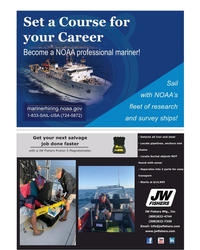 )
March 2024 - Marine Technology Reporter page: 7
)
March 2024 - Marine Technology Reporter page: 7Set a Course for your Career Become a NOAA professional mariner! Sail with NOAA’s fleet of research marinerhiring.noaa.gov 1-833-SAIL-USA (724-5872) and survey ships! - Detects all iron and steel Get your next salvage - Locate pipelines, anchors and job done faster chains with a JW Fishers
-
 )
April 2024 - Maritime Reporter and Engineering News page: 39
)
April 2024 - Maritime Reporter and Engineering News page: 39Tech Files Latest Products, Systems and Ship Designs “Wall Climbing Robot” Danish Pilot calls gets ClassNK Nod LEGO Model "A tribute build to a work life at sea" Image courtesy MOL, Sumitomo Heavy Industries lassNK granted its Innovation Endorse- Image courtesy Espen Andersen/DanPilot ment for
-
 )
April 2024 - Maritime Reporter and Engineering News page: 38
)
April 2024 - Maritime Reporter and Engineering News page: 38Tech Files Latest Products, Systems and Ship Designs Zero-Emission Mooring Service of a Tanker Consulmar achieved a milestone by executing what it calls ing boat Castalia, which operates on full electric propulsion. the world's ? rst zero-emissions mooring service for a tanker. Equipped with two 150 kW
-
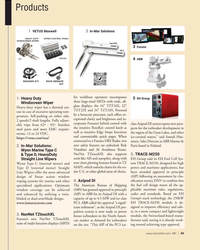 )
April 2024 - Marine News page: 43
)
April 2024 - Marine News page: 43, by a hexacore processor, each offers ex- ceptional clarity and brightness and in- 2 speeds/2 shaft lengths. Fully adjust- able wipe from 62º - 92º. Stainless corporate Furuno’s hybrid control with class Azipod DI system opens new pros- the intuitive RotoKey control knob as pects for the icebreaker developmen
-
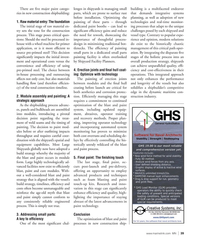 )
April 2024 - Marine News page: 39
)
April 2024 - Marine News page: 39There are ? ve major paint catego- lenges in shipyards is managing small building is a multifaceted endeavor ries in new construction shipbuilding: parts, which are prone to surface rust that demands integrative systems before installation. Optimizing the planning, as well as adoption of new 1.
-
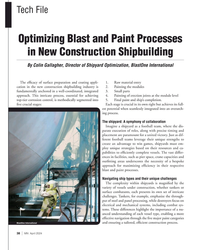 )
April 2024 - Marine News page: 38
)
April 2024 - Marine News page: 38Tech File Optimizing Blast and Paint Processes in New Construction Shipbuilding By Colin Gallagher, Director of Shipyard Optimization, BlastOne International The ef? cacy of surface preparation and coating appli- 1. Raw material entry cation in the new construction shipbuilding industry is 2. Painting
-
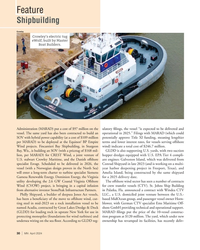 )
April 2024 - Marine News page: 30
)
April 2024 - Marine News page: 30Feature Shipbuilding Crowley Crowley’s electric tug eWolf, built by Master Boat Builders. Administration (MARAD) put a cost of $97 million on the ulatory ? lings, the vessel “is expected to be delivered and vessel. The same yard has also been contracted to build an operational in 2025.” Filings with
-
 )
February 2024 - Maritime Reporter and Engineering News page: 24
)
February 2024 - Maritime Reporter and Engineering News page: 24R&D marinized version of the V228 product from 8 to 16 cylinders. through improved lifecycle cost, trade-offs, it also allows us That engine is called the V228 for the bore size in millimeters. to do concurrent design and reliability demonstrations. We’re With the advent of emissions regulations for EPA
-
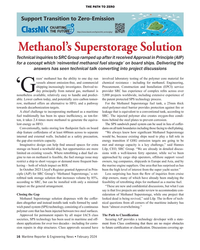 )
February 2024 - Maritime Reporter and Engineering News page: 16
)
February 2024 - Maritime Reporter and Engineering News page: 16THE PATH TO ZERO Methanol’s Superstorage Solution Technical inquiries to SRC Group ramped up after it received Approval in Principle (AIP) for a concept which ‘reinvented methanol fuel storage’ on board ships. Delivering the answers has seen technical talk converting into project discussions
-
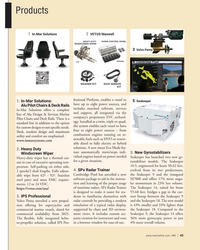 )
February 2024 - Marine News page: 43
)
February 2024 - Marine News page: 43on either side, evolved from its two predecessors, 4. SPx Radar Trainer 2 speeds/2 shaft lengths. Fully adjust- able wipe from 62º - 92º. Stainless Cambridge Pixel has unveiled a new the Seakeeper 9 and the inaugural software package to aid in the instruc- M7000 and offers 17% more angu- steel
-
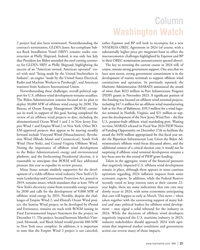 )
February 2024 - Marine News page: 21
)
February 2024 - Marine News page: 21Column Washington Watch 2 project had also been terminated. Notwithstanding the rather Equinor and BP will look to recompete for a new contract’s termination, GLDD’s Jones Act-compliant Sub- NYSERDA OREC Agreement in 2024 (of course, with a sea Rock Installation Vessel (SRIV) remains under con- substantial
-
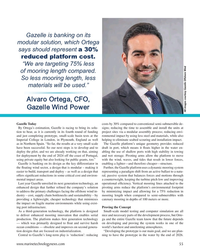 )
January 2024 - Marine Technology Reporter page: 55
)
January 2024 - Marine Technology Reporter page: 55Gazelle is banking on its modular solution, which Ortega says should represent a 30% reduced platform cost. “We are targeting 75% less of mooring length compared. So less mooring length, less materials will be used.” Alvaro Ortega, CFO, Gazelle Wind Power All images courtesy Gazelle Offshore Wind Gaze
-
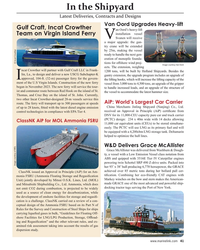 )
January 2024 - Maritime Reporter and Engineering News page: 41
)
January 2024 - Maritime Reporter and Engineering News page: 41In the Shipyard Latest Deliveries, Contracts and Designs Van Oord Upgrades Heavy-lift Gulf Craft, Incat Crowther an Oord’s heavy-lift installation vessel Team on Virgin Island Ferry VSvanen will receive a major upgrade: the gan- try crane will be extended by 25m, making the vessel ready to handle the
-
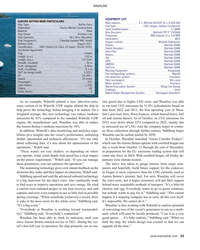 )
January 2024 - Maritime Reporter and Engineering News page: 33
)
January 2024 - Maritime Reporter and Engineering News page: 33WASALINE EQUIPMENT LIST AURORA BOTNIA MAIN PARTICULARS Main engines: 4 × Wärtsilä 8V31DF (4 × 4,400 kW) Ship Type: RoPax Ferry Fuel type: LNG, biogas, battery (Leclanche) Shipbuilder: Rauma Marine Constructions Total installed power: 17,6MW Material: Steel Bow thrusters: Wärtsilä FPP
-
 )
January 2024 - Maritime Reporter and Engineering News page: 20
)
January 2024 - Maritime Reporter and Engineering News page: 20TECH FEATURE Figure 4. The vessel’s cargo holds feature Figure 5. The walls of the cargo holds All images courtesy of The Interlake Steamship Company ? at bottoms that accommodate the use bene? t from a zinc-based coating that of heavy machinery, which necessitated provides durability in an area
-
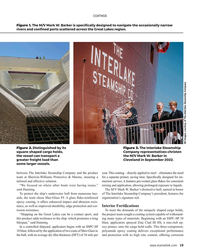 )
January 2024 - Maritime Reporter and Engineering News page: 19
)
January 2024 - Maritime Reporter and Engineering News page: 19COATINGS Figure 1. The M/V Mark W. Barker is speci? cally designed to navigate the occasionally narrow rivers and con? ned ports scattered across the Great Lakes region. All images courtesy of The Interlake Steamship Company Figure 2. Distinguished by its Figure 3. The Interlake Steamship square-shaped
-
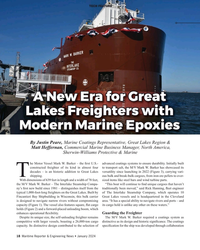 )
January 2024 - Maritime Reporter and Engineering News page: 18
)
January 2024 - Maritime Reporter and Engineering News page: 18TECH FEATURE A New Era for Great Lakes Freighters with Modern Marine Epoxies By Justin Peare, Marine Coatings Representative, Great Lakes Region & Matt Heffernan, Commercial Marine Business Manager, North America, Sherwin-Williams Protective & Marine he Motor Vessel Mark W. Barker – the ? rst U.S.
-
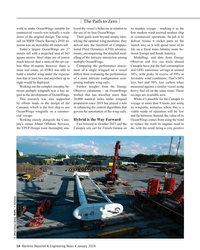 )
January 2024 - Maritime Reporter and Engineering News page: 14
)
January 2024 - Maritime Reporter and Engineering News page: 14The Path to Zero work to make OceanWings suitable for lyzed the vessel’s behavior in relation to its maiden voyage – marking it as the commercial vessels was actually a scale the use of its four OceanWings. ? rst modern wind assisted modern ship down of the original design. The wing- Their goals went
-
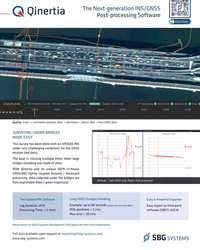 )
November 2023 - Marine Technology Reporter page: 5
)
November 2023 - Marine Technology Reporter page: 5The Next-generationINS/GNSS Post-processing Software Quality: Green -> centimetric position; Blue -> decimetric < 30cms; Red -> Raw GNSS data SURVEYING UNDER BRIDGES Å GNSS Altitude (m) - Merged Å Altitude (m) - Merged MADE EASY This survey has been done with an APOGEE INS under very challenging condition
